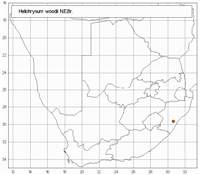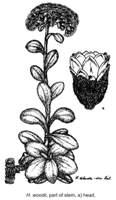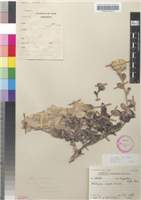Origin of name:
Discovered by John Medley Wood (1825-1915); farmer, trader and botanist of KwaZulu-Natal, curator of the Durban Botanic Garden from 1882 and founder of KwaZulu-Natal Herbarium.
Diagnostic characters:
Plant covered in beige woolCompact inflorescenceLight yellow bracts
Description:
A small well-branched shrub up to c. 300 mm tall, branches greyish-white woolly, densely leafy. Leaves 15�50 x 5�15 mm, diminishing upwards, elliptic to obovate, obtuse, gradually narrowed to a broad petiole-like base, thinly woolly above, thickly white-woolly below, triplinerved, nerves faintly raised below. Heads homogamous, campanulate, 4�5 mm long, 5�6 mm across the radiating bracts, in compact rounded corymbose clusters 30�50 mm across terminating the branches. Involucral bracts in c. 5 series, graded, loosely imbricate, outer woolly, inner about equaling the flowers, tips obtuse, opaque, dull, pale straw-yellow. Receptacle with pit margins slightly produced. Flowers 11�17, yellow. Achenes 1 mm, cylindric, with myxogenic duplex hairs. Pappus bristles many, scabrid, about equaling the corolla, bases not cohering.
Flowers in mid-winter (July).
Distribution:
Endemic to KwaZulu-Natal; recorded only from a very small area in the contiguous Pinetown, Camperdown and New Hanover districts, on the edges and faces (southerly aspect) of Table Mountain Sandstone cliffs 600-900 m above sea level.
Savanna Biome.
Notes:
Rarely collected. Allied to the Mpumalanga mountain endemic, H. homilochrysum but easily distinguished by its differently shaped leaves and dull, opaque involucral bracts, the outer much shorter than the inner.
Taxonomy:
Literature:
Helichrysum woodii N.E. Br. in Kew Bull. 1906: 21 (1906); Hilliard, Compositae in Natal 215 (1977).
Type:
KwaZulu-Natal, Pinetown district, on rocks near Emberton, Wood 5761 (K, holo.; M, iso.).
Synonym(s):
Vouchers:
Hilliard 4832 (E; K; NU; PRE; S).

